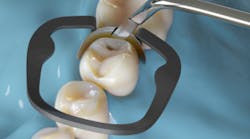Pearls for Your Practice: Akro-Flex Composite Instrument by HuFriedyGroup
A few years ago, I was grilling a nice chateaubriand and it turned out gorgeous. Perfectly seared with a bit of pink in the middle … juicy and tender, just the way I like it. When I took it off the heat, I let it rest for a few minutes. When I started carving it, I did not have the easiest time. In fact, I was struggling. Uh oh! Did I overcook this thing? When I tasted it, it was clear that I hadn’t overcooked it—it was my knife that was the problem. I looked at the knife block and realized they were the same knives I bought in my early 20s. I knew this was no good. Here I am in my 40s with cheap, old knives.
Chefs need good knives, and restorative dentists need good composite instruments. Yet most of us work with whatever we’ve had for years. The Akro-Flex Composite Instrument by HuFriedyGroup is a great place to start with that armamentarium upgrade! It’s very flexible and ultrathin, which makes it great for shaping line angles around anterior composites. Those areas where we blend from the facial into the interproximal are often overcontoured, leaving us with blocky embrasures and restorations that just look off.
More Pearls:
Re-Gen Bioactive Endosealer by Vista Apex
The Akro-Flex can combat that and allow you to shape that composite more naturally around that curve. The flexibility is remarkable, as the working end of the Akro-Flex can bend up to 45 degrees, allowing you to access areas that stiffer instruments couldn’t without gouging or divoting the composite.
For posterior teeth, I use the Akro-Flex Composite Instrument to help refine my cuspal inclines. The flexibility allows me to get that rounded, convex surface that cuspal inclines have naturally. It also helps for carving that marginal ridge roll on class II restorations. This instrument is in my everyday restorative kit, not just for anteriors.
Made out of nickel titanium, the Akro-Flex does not stick to composite, and it keeps its flexibility well over time. Because of this flexibility, the Akro-Flex can be used the way a brush is sometimes used in anterior composite work. Brushes are great for creating imperceptible results in anterior composites by dragging the material onto and over the bevel. The problem with brushes is infection control. They are hard to sterilize and reuse, but the Akro-Flex works similarly without those concerns. If you use brushes a lot to create beautiful anterior composites, try the Akro-Flex instead. You’ll get similar results with better logistics!
All in all, the Akro-Flex is a quality instrument that will make your resin composite restorations easier. No one wants to cut great steak with dull knives, and no one wants to place beautiful composites with shabby old instruments.
Editor's note: This article appeared in the September 2023 print edition of Dental Economics magazine. Dentists in North America are eligible for a complimentary print subscription. Sign up here.







